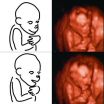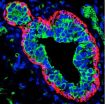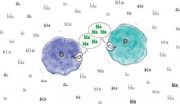(Press-News.org)
VIDEO:
This movie shows a pregnant chimpanzee undergoing an ultrasound imaging procedure to explore brain growth in her fetus.
Click here for more information.
Humans' superior brain size in comparison to their chimpanzee cousins traces all the way back to the womb. That's according to a study reported in the September 25 issue of Current Biology, a Cell Press publication, that is the first to track and compare brain growth in chimpanzee and human fetuses.
"Nobody knew how early these differences between human and chimp brains emerged," said Satoshi Hirata of Kyoto University.
Hirata and colleagues Tomoko Sakai and Hideko Takeshita now find that human and chimp brains begin to show remarkable differences very early in life. In both primate species, the brain grows increasingly fast in the womb initially. After 22 weeks of gestation, brain growth in chimpanzees starts to level off, while that of humans continues to accelerate for another two months or more. (Human gestation time is only slightly longer than that of chimpanzees, 38 weeks versus 33 or 34 weeks.)
The findings are based on 3D ultrasound imaging of two pregnant chimpanzees from approximately 14 to 34 weeks of gestation and comparison of those fetal images to those of human fetuses. While early brain differences were suspected, no one had previously measured the volume of chimpanzee brains as they develop in the womb until now.
The findings are part of a larger effort by the research team to explore differences in primate brains. In another Current Biology report published last year, they compared brain development in chimps versus humans via magnetic resonance imaging (MRI) scans of three growing chimpanzees from the age of six months to six years (see http://www.eurekalert.org/pub_releases/2011-08/cp-lhc_1080511.php).
"Elucidating these differences in the developmental patterns of brain structure between humans and great apes will provide important clues to understand the remarkable enlargement of the modern human brain and humans' sophisticated behavior," Sakai said.
The researchers say they now hope to explore fetal development in particular parts of the brain, including the forebrain, which is critical for decision making, self-awareness, and creativity.
INFORMATION:
Sakai et al.: "Fetal brain development in chimpanzees versus humans"
Human brains outpace chimp brains in the womb
2012-09-24
ELSE PRESS RELEASES FROM THIS DATE:
Pregnancy complications up to twice higher in women born preterm
2012-09-24
This press release is available in French. Women who were born premature are more likely to have pregnancy complications than women who weren't, according to data analyzed by a team lead by Dr. Anne Monique Nuyt, a neonatal specialist and researcher at the Sainte-Justine Mother and Child University Hospital Center and University of Montreal. This is the first study to clearly show the impact of preterm birth (i.e. before 37 weeks of gestation) itself on pregnancy risks. "We knew that to be born with a low birth weight could be associated with increased risk of pregnancy ...
Research shows ants share decision-making, lessen vulnerability to 'information overload'
2012-09-24
TEMPE, Ariz. – Scientists at Arizona State University have discovered that ants utilize a strategy to handle "information overload." Temnothorax rugatulus ants, commonly found living in rock crevices in the Southwest, place the burden of making complicated decisions on the backs of the entire colony, rather than on an individual ant.
In a study published in the early, online version of scientific journal Current Biology, Stephen Pratt, an associate professor in ASU's School of Life Sciences in the College of Liberal Arts and Sciences, and Takao Sasaki, a graduate student ...
Researchers at Harvard's Wyss Institute engineer novel DNA barcode
2012-09-24
VIDEO:
DNA origami is a process that can be used to self-assemble shapes that are of nanometer dimensions -- 100 nanometers is about 1,000 times shorter than the width of an...
Click here for more information.
BOSTON, September 24, 2012—Much like the checkout clerk uses a machine that scans the barcodes on packages to identify what customers bought at the store, scientists use powerful microscopes and their own kinds of barcodes to help them identify various parts of a cell, ...
Study uncovers mechanism by which tumor suppressor MIG6 triggers cell suicide
2012-09-24
New York, NY and Uppsala, Sweden, September 24, 2012 – Death plays a big role in keeping things alive. Consider the tightly orchestrated suicide of cells--a phenomenon essential to everything from shaping an embryo to keeping it free of cancer later in life. When cells refuse to die, and instead multiply uncontrollably, they become what we call tumors. An intricate circuitry of biochemical reactions inside cells coordinates their self-sacrifice. Tracing that circuitry is, naturally, an important part of cancer research.
In a major contribution to that effort Dr. Ingvar ...
New study shows PTSD symptoms reduced in combat-exposed military via integrative medicine
2012-09-24
SAN DIEGO (Sept. 24, 2012) – Healing touch combined with guided imagery (HT+GI) provides significant clinical reductions in post-traumatic stress disorder (PTSD) symptoms for combat-exposed active duty military, according to a study released in the September issue of Military Medicine.
The report finds that patients receiving these complementary medicine interventions showed significant improvement in quality of life, as well as reduced depression and cynicism, compared to soldiers receiving treatment as usual alone.
The study, led by the Scripps Center for Integrative ...
Pacific Islanders have high obesity, smoking rates
2012-09-24
ANN ARBOR, Mich.—In the first study to detail the health of Pacific Islanders living in the United States, University of Michigan researchers have found alarmingly high rates of obesity and smoking.
The preliminary findings are being presented today (Sept. 24) at a conference in Los Angeles on health disparities among Native Hawaiians and Pacific Islanders.
"Native Hawaiians and Pacific Islanders are the second fastest growing minority population in the U.S.," said Sela Panapasa, a researcher at the U-M Institute for Social Research and principal investigator of the ...
Vitamin D deficiency increases risk of heart disease
2012-09-24
New research from the University of Copenhagen and Copenhagen University Hospital shows that low levels of vitamin D are associated with a markedly higher risk of heart attack and early death. The study involved more than 10,000 Danes and has been published in the well-reputed American journal Arteriosclerosis, Thrombosis and Vascular Biology.
Vitamin D deficiency has traditionally been linked with poor bone health. However, the results from several population studies indicate that a low level of this important vitamin may also be linked to a higher risk of ischemic heart ...
Climate is changing the Great Barrier Reef
2012-09-24
Satellite measurement of sea surface temperatures has yielded clear evidence of major changes taking place in the waters of Australia's Great Barrier Reef over the past 25 years, marine scientists have found.
The changes have big implications for the future management of the GBR and its marine protected areas say Dr Natalie Ban and Professor Bob Pressey of the ARC Centre of Excellence for Coral Reef Studies and James Cook University, who led the study with Dr Scarla Weeks from the University of Queensland.
"When we looked back at satellite data collected since 1985, ...
World Heart Federation says heart health starts earlier than you think
2012-09-24
A new multi-national survey reveals the extent of misconceptions about when is the right time to start taking action to prevent cardiovascular disease (CVD). In a four-country survey sample of 4,000 adults, 49 per cent answered age 30 years or older when asked at what age they believe people should start to take action about their heart health to prevent conditions such as heart disease and stroke. The fact is that CVD can affect people of all ages and population groups, and the risk begins early in life through unhealthy diets, lack of physical activity and exposure to ...
Cellular eavesdropping made easy
2012-09-24
It is much harder to keep up with a conversation in a crowded bar than in a quiet little café, but scientists wishing to eavesdrop on cells can now do so over the laboratory equivalent of a noisy room. A new method devised by scientists at the European Molecular Biology Laboratory (EMBL) in collaboration with the German Cancer Research Centre (DKFZ), both in Heidelberg, Germany, provides a new approach for studying the proteins cells release to communicate with each other, react to changes, or even to help them move. Published online today in Nature Biotechnology, the work ...



